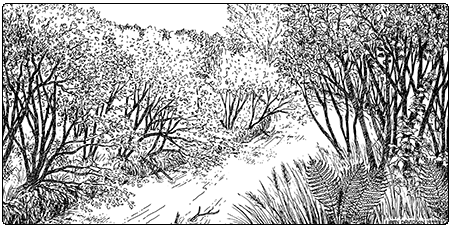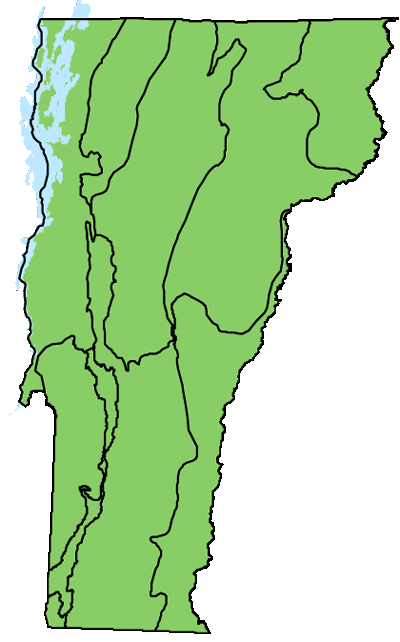Ecology and Physical Setting 
Alluvial Shrub Swamps are common in the floodplains of many of our smaller rivers and streams. These streams rise quickly in response to rainstorms and snowmelt, so their floodplains are inundated by overbank stream flows at least once, and often multiple times per year. This high flood frequency is partly responsible for the long-term maintenance of a shrub-dominated community. Few tree species can tolerate this hydrologic regime. Alders have a competitive advantage because they can tolerate repeated flooding and because their stems can bend under strong currents.
The alluvial soils of this community are typically sandy or silty loams deposited by flood waters as they slow down and lose energy when they expand into the floodplains. The majority of this alluvial deposition occurs directly adjacent to the top of the stream bank, with less deposition farther from the stream channel. The typical result of this alluvial process is the formation of a narrow, raised levee at the top of the bank, with gentle slopes tilting downward away from the river. These soils do not have distinct horizon development due to the frequent addition of alluvium. Alluvial Shrub Swamps commonly grade into Alder Swamps, Sedge Meadows, or marshes, which occur on soils with longer saturation and a greater organic content farther from the river. These adjacent wetland types may receive some alluvial deposition, but alluvium does not dominate soil formation as it does in the Alluvial Shrub Swamp. Alluvial Shrub Swamps may also grade into floodplain forests.
 As with all floodplain communities, the river or stream is the dominant natural disturbance force. The stream channel migrates across the floodplain over time, eroding soils and vegetation in one area and depositing soils in another. Unusually long duration flooding may kill even the tolerant alders and willows that dominate this community. Beaver may create temporary impoundments and cut substantial amounts of woody vegetation for food and dam construction.
As with all floodplain communities, the river or stream is the dominant natural disturbance force. The stream channel migrates across the floodplain over time, eroding soils and vegetation in one area and depositing soils in another. Unusually long duration flooding may kill even the tolerant alders and willows that dominate this community. Beaver may create temporary impoundments and cut substantial amounts of woody vegetation for food and dam construction.
Vegetation
This community is typically dominated by speckled alder, which grows as scattered plants or forms dense thickets and reaches heights of 10 to 12 feet. Boxelder may also be present, as may shrub willows. Virgin’s bower vines commonly climb the alders—the feathery fruits are spectacular in the fall.
The herbaceous layer of Alluvial Shrub Swamps has many similarities with some floodplain forests. Plants common to both include ostrich fern, riverbank wild rye, Virginia wild rye, and wild cucumber. Other frequent herbs include tall meadow rue, Jack-in-the-pulpit, Joe-pye weed, and several species of asters and goldenrods. Bryophytes are typically sparse or absent due to the annual deposition of alluvial soils.
Wildlife Habitat
Alluvial Shrub Swamps provide important breeding habitat for many species of migratory birds, including alder flycatcher, common yellowthroat, yellow warbler, chestnut-sided warbler, swamp sparrow, and gray catbird. American woodcocks probe the moist, soft soils of these swamps for earthworms and insects. Blue-winged warbler and yellow-billed cuckoo—two rare breeding birds in Vermont—may nest in these swamps, especially in warmer regions.
Alluvial Shrub Swamps and other naturally vegetated riparian areas along rivers and streams provide critical movement corridors for many species of wildlife, especially in developed areas of Vermont like the Champlain Valley. River otter, mink, and beaver are all found in Alluvial Shrub Swamps and adjacent rivers and streams. Alder is one of the preferred foods and building materials for beavers, whose dams are a common sight spanning streams and swamps. Wood turtles range thousands of feet from their home streams and may be found feeding and basking in this community and associated herbaceous openings.
The larvae of the rare ostrich fern borer moth feed on the lower stems of ostrich fern, a common species in Alluvial Shrub Swamps and floodplain forests.
Related Communities
- Floodplain forests along rivers share many characteristics with Alluvial Shrub Swamps, but are distinguished by their tree canopy and less frequent flooding. Boreal Floodplain Forests in particular can have sparse canopy cover and often intergrade with Alluvial Shrub Swamps.
- Alder Swamp typically has organic or organic-rich mineral soils that remain saturated for much of the year, whereas soils of Alluvial Shrub Swamps may dry out considerably between flooding events.
Conservation Status and Management Considerations
Many good examples of Alluvial Shrub Swamps are protected on conserved lands, but the functions and values of all riparian areas need to be maintained or restored. Streamside wetlands and riparian areas are very important movement corridors for many wildlife species. Fragmentation of these wetlands and corridors threatens the long-term integrity of terrestrial and aquatic wildlife populations. Agriculture in Vermont’s smaller river valleys has eliminated many floodplain communities, including Alluvial Shrub Swamps.
Distribution/Abundance 
Alluvial Shrub Swamps occur along smaller rivers and streams throughout Vermont. These and closely related communities are found across the eastern United States and Canada.
Characteristic Plants
Trees
Occasional Species
American elm – Ulmus americana
Boxelder – Acer negundo
Shrubs and Vines
Abundant Species
Speckled alder – Alnus incana
Occasional to Locally Abundant Species
Willows – Salix spp.
Virgin’s bower – Clematis virginiana
Meadowsweet – Spiraea alba
Silky dogwood – Cornus amomum
Black elderberry – Sambucus nigra
Wild raisin – Viburnum nudum var. cassinoides
Herbs
Abundant Species
Ostrich fern – Matteuccia struthiopteris
Occasional to Locally Abundant Species
Riverbank wild rye – Elymus riparius
Virginia wild rye – Elymus virginicus
Wild cucumber – Echinocystis lobata
Tall meadow rue – Thalictrum pubescens
Jack-in-the-pulpit – Arisaema triphyllum
Joe-pye weed – Eutrochium maculatum
Flat-topped aster – Doellingeria umbellata
Purple-stemmed aster – Symphyotrichum puniceum
Rough-stemmed goldenrod – Solidago rugosa
Late goldenrod – Solidago gigantea
Bluejoint grass – Calamagrostis canadensis
False hellebore – Veratrum viride
Non-native Invasive Plants
Goutweed – Aegopodium podagraria
Japanese knotweed – Fallopia japonica
Moneywort – Lysimachia nummularia
Rare Plants
Auricled twayblade – Neottia auriculata
Wild garlic – Allium canadense
Northern clustered sedge – Carex arcta
Wiegand’s wild rye – Elymus wiegandii
Satiny willow – Salix pellita
Associated Animals
Gray treefrog – Hyla versicolor
Meadow jumping mouse – Zapus hudsonicus
Meadow vole – Microtus pennsylvanicus
River otter – Lontra canadensis
Mink – Neovison vison
American beaver – Castor canadensis
American woodcock – Scolopax minor
Ruffed grouse – Bonasa umbellus
Yellow warbler – Setophaga petechia
Common yellowthroat – Geothlypis trichas
Chestnut-sided warbler – Setophaga pensylvanica
Alder flycatcher – Empidonax alnorum
Swamp sparrow – Melospiza georgiana
Gray catbird – Dumetella carolinensis
Green heron – Butorides virescens
Harvester butterfly – Feniseca tarquinius
Rare and Uncommon Animals
Wood turtle – Glyptemys insculpta
Blue-winged warbler – Vermivora cyanoptera
Yellow-billed cuckoo – Coccyzus americanus
Ostrich fern borer moth – unnamed Papaipema species
Places to Visit
Wenlock Wildlife Management Area, Ferdinand, Vermont Fish and Wildlife Department (VFWD)
Victory Basin Wildlife Management Area, Victory, VFWD
South Bay Wildlife Management Area, Coventry, VFWD
Nulhegan Basin, Silvio O. Conte National Fish and Wildlife Refuge, Lewis, U.S. Fish and Wildlife Service
Martins Brook, Wrightsville Reservoir, Middlesex, Vermont Department of Environmental Conservation
